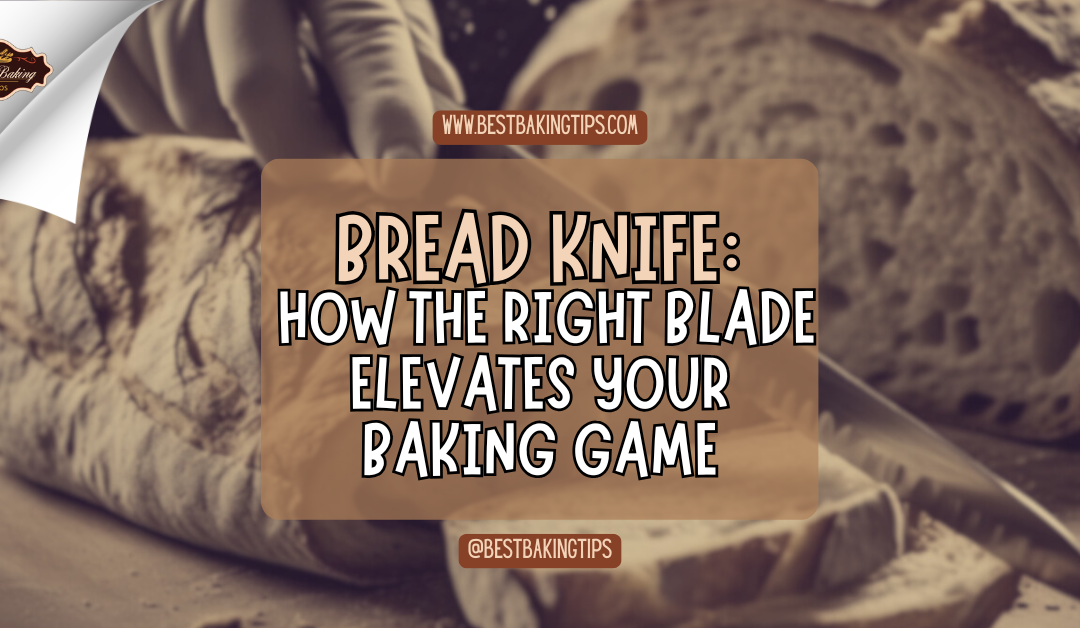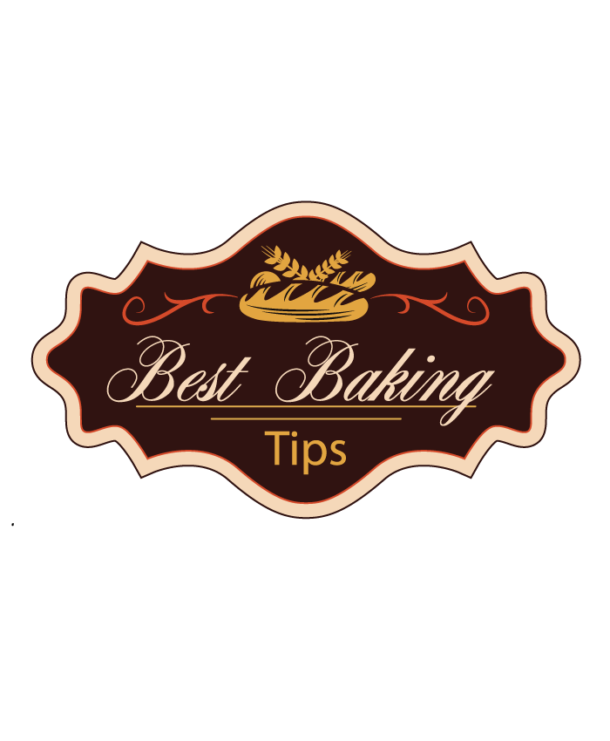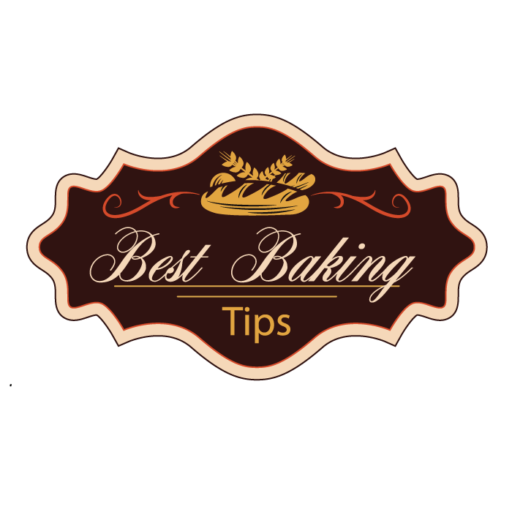==================
Affiliate Statement
Best Baking Tips is supported by our audience. When you purchase through one of our links, we may earn a small affiliate commission. As an Amazon Associate I earn from qualifying purchases. Your cost is not affected.
==================
Investing in the best bread knife can make all the difference if you’re tired of squished or uneven slices. I used to struggle with cutting bread using typical knives, always with squished and uneven slices. It was so frustrating! Then, I decided to invest in a good knife for bread designed for slicing bread, especially soft bread.
These bread knives ensure perfect slices every time, and my loaves look much better. Trust me, having the right knife is a game-changer in the kitchen. If you love fresh bread as much as I do, it’s worth the investment. Join me as we unravel the beauty of slicing bread with these essential tools.
Slice Perfect: The Essential Bread Knife for Flawless Slicing
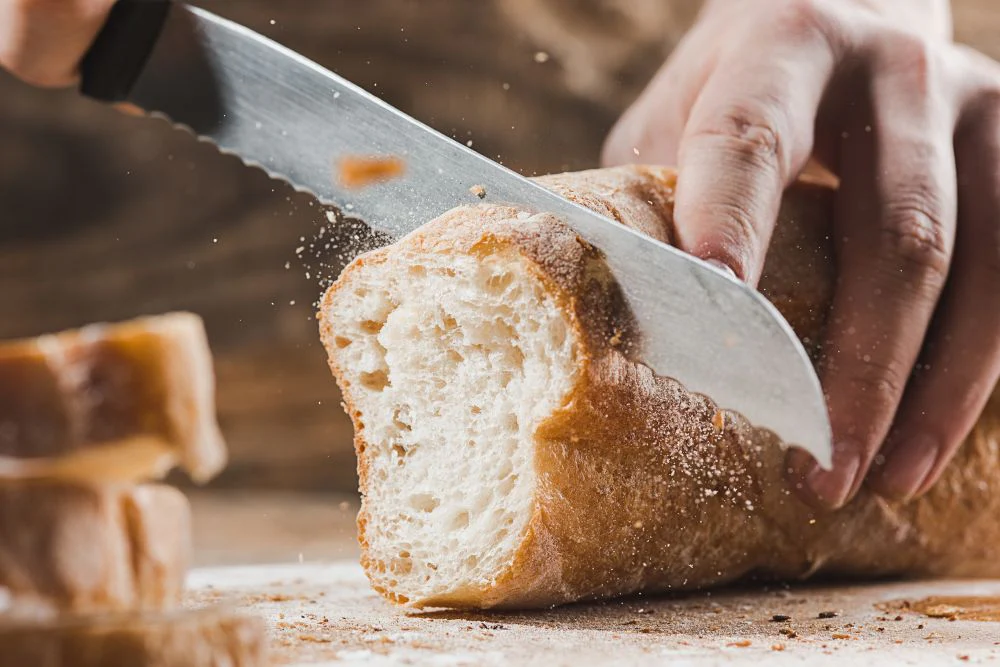
Photo by: Banneton Man
Discover the ultimate solution to achieving flawless bread slices with the essential knife designed for perfect cutting. If you’ve ever struggled with uneven or squished slices or frequently cut crusty bread and need thin slices, this knife is here to transform your baking experience.
Imagine effortlessly slicing through crusty bread without crushing it, ensuring each slice is thin, uniform, and neat. Having the right knife for bread makes a difference. It lets you cut beautiful, professional-looking slices right in your kitchen.
Whether you’re a seasoned baker or just passionate about fresh, homemade bread, this essential tool is a must-have in your kitchen arsenal. Elevate your baking and dining with the essential knife that turns any loaf into a masterpiece of sliced perfection.
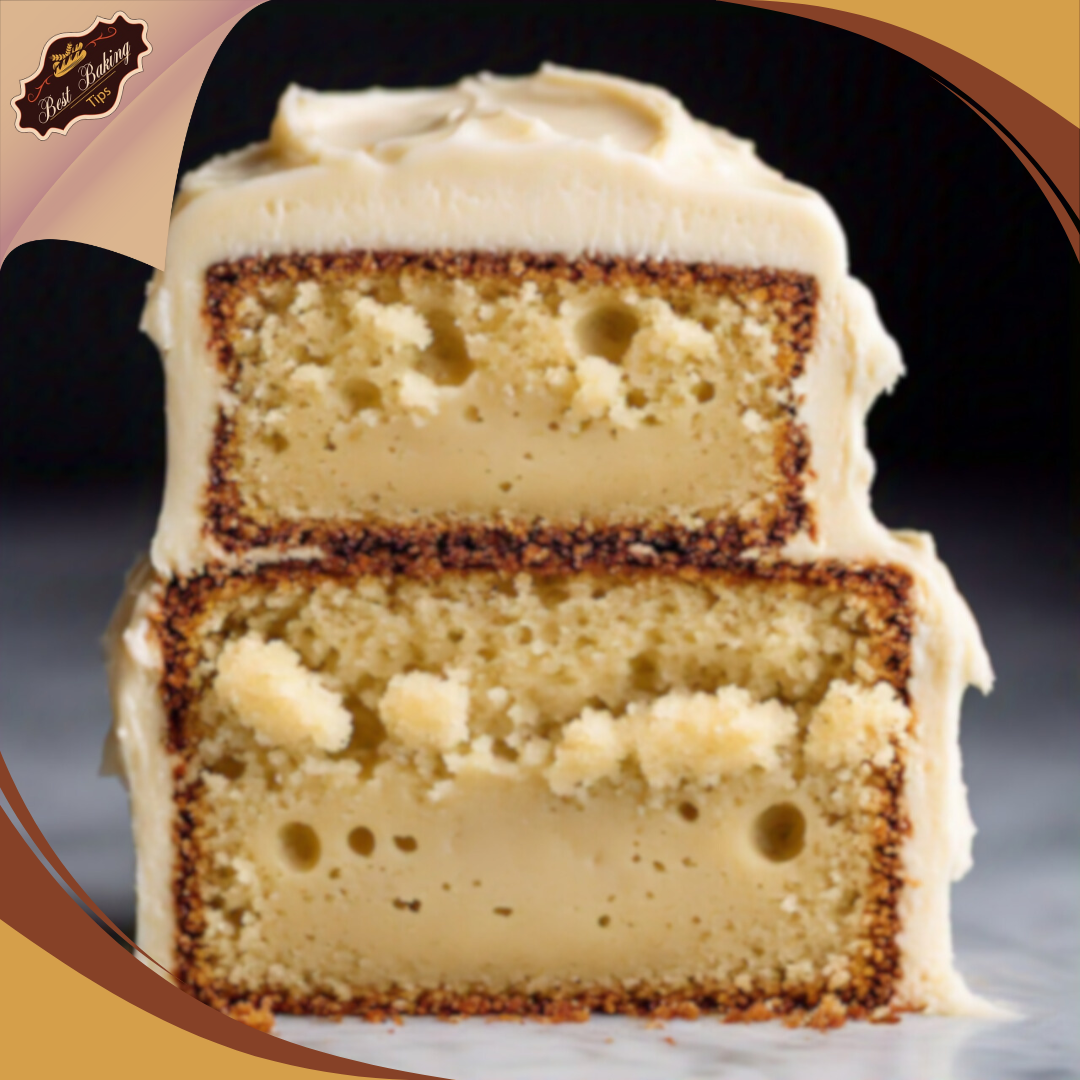
Key Highlights
- Bread knife is a long, serrated knife perfect for cutting bread.
- Bread knives typically have long blades, 8-10 inches, which allow for smooth, even slices and accommodate different bread sizes.
- Offset Serrated Bread Knife and Straight Serrated Bread Knife are bread knives.
- The biggest difference between using a bread knife and other kitchen knives is their blade design and how they interact with food. For the best results when cutting crusty or softer bread, it is recommended to use one of the best serrated bread knives specifically designed for this purpose instead of kitchen knives.
- To ensure your bread knife slices perfectly for years, you must care for it from washing to sharpening.
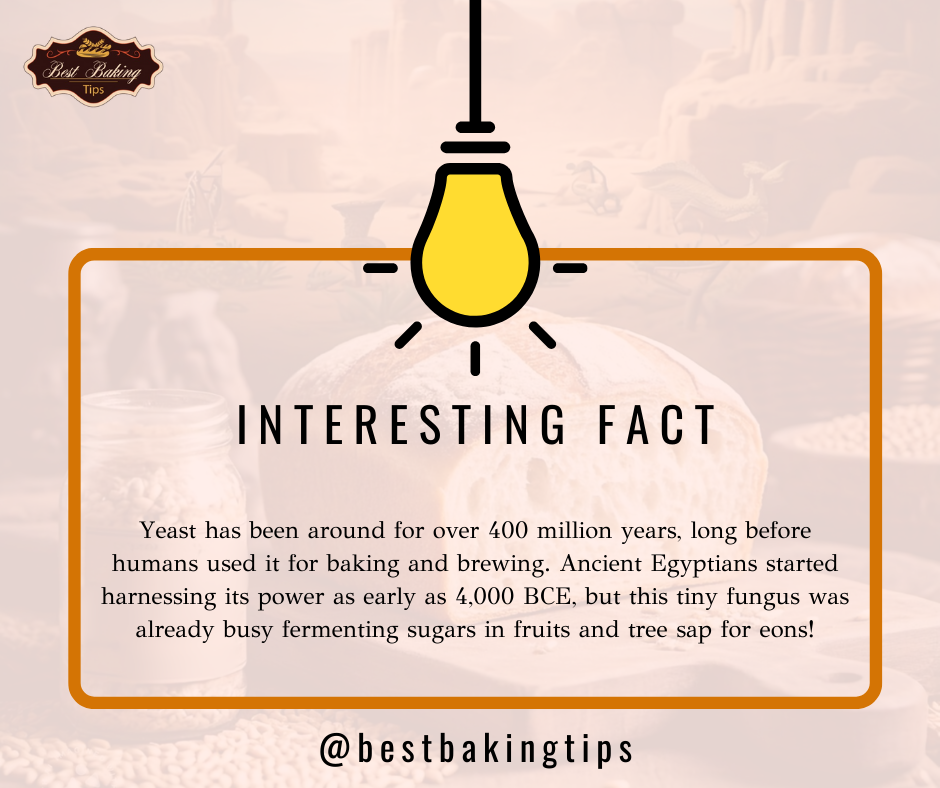
What Is A Bread Knife? Exploring the Essential Tool for Perfect Slicing
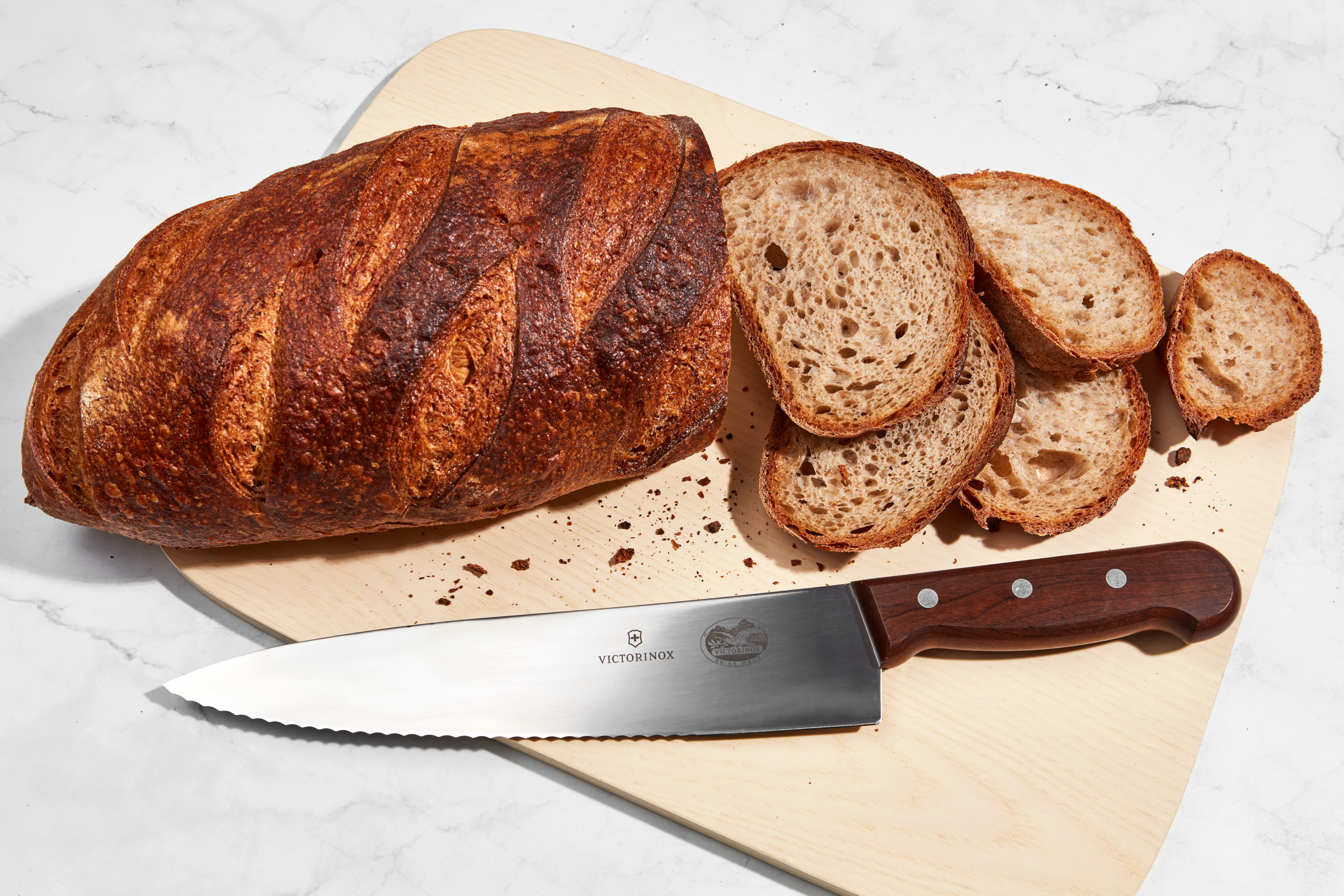
Photo by: Epicurious
It is a long, serrated knife designed for cutting bread. The pointed serrations, or pointed teeth, on the blade help to saw through bread without tearing or crushing it, resulting in clean, even slices. Bread knives typically have blades that are between 8 and 12 inches long. They are a vital tool in any baker’s or cook’s kitchen, as serrated bread knives can be used to cut various bread, including crusty loaves, soft sandwich bread, and delicate pastries. In addition to bread, these knives can be used to cut other foods with soft interiors and hard exteriors, such as ripe tomatoes, melons, and pineapples.
Why Are Bread Knives Typically So Long?
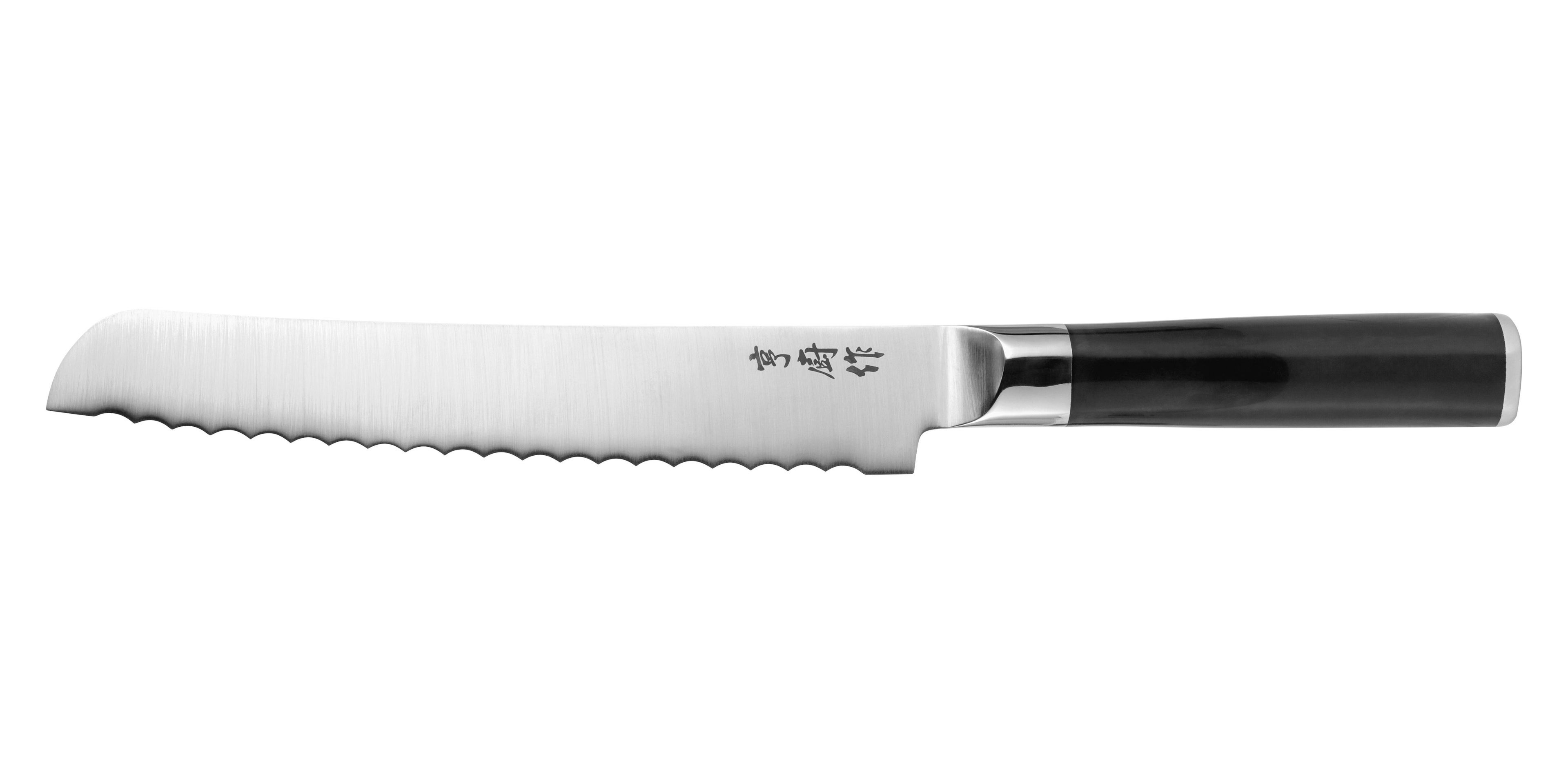
Photo by: BBC Good Food
Bread knives have long blades, typically 8-10 inches, for a few key reasons:
- Smooth, Even Slices: A longer blade allows you to make full, sweeping cuts through a loaf of bread in one go. This helps achieve consistent slice thickness and minimizes tearing, especially with larger loaves. A shorter blade might require multiple strokes, increasing the chance of tearing the bread.
- Control and Leverage: The additional length provides more leverage and control over the bread knife. This is especially helpful when cutting through crusty bread, as you can apply more even pressure throughout the cut.
- Maneuvering Around Loaves: The extended blade lets you navigate the curves and contours of a loaf more easily. This allows you to follow the shape of the bread and minimize wasted crust. You might end up with more awkward cuts and leftover crust pieces with a shorter blade.
- Accommodating Different Bread Sizes: A longer blade can handle a wider variety of bread sizes, from small baguettes to large sourdough loaves, making it a more versatile tool for various bread-cutting tasks.
Here’s an analogy: Imagine using a short saw with dull teeth to cut a thick log. It would be difficult to make clean cuts, and even cuts would require more effort. A longer saw with sharp teeth provides better control and leverage and allows for smoother cutting. The same principle applies to bread knives and the size of the loaf.
Exploring Types of Bread Knives
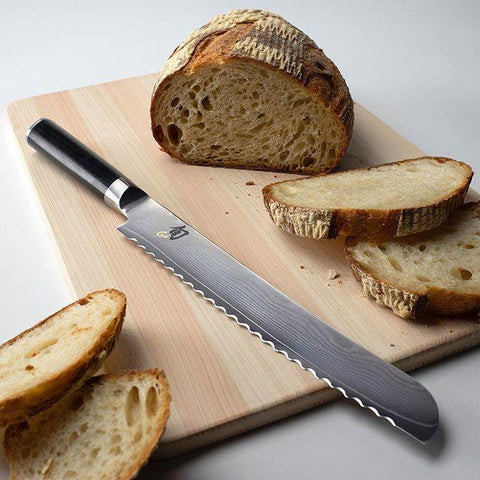
Photo by: House of Knives
There are two primary types of serrated knives made specifically for cutting bread:
- Offset Serrated Bread Knife: This type of knife has an offset handle set higher than the blade. This design helps prevent your knuckles from scraping against the cutting board when slicing bread.
- Straight Serrated Bread Knife: This type of knife has a straight handle that is in line with the blade. Due to their long blade, straight-serrated bread knives are usually less expensive than offset-serrated knives and can be ideal for cutting through crusty loaves and soft sandwich bread.
What’s the Best Option to Use?
Choosing the best serrated knife for bread for you depends on your priorities and how you plan to use it. Here’s a breakdown to help you decide:
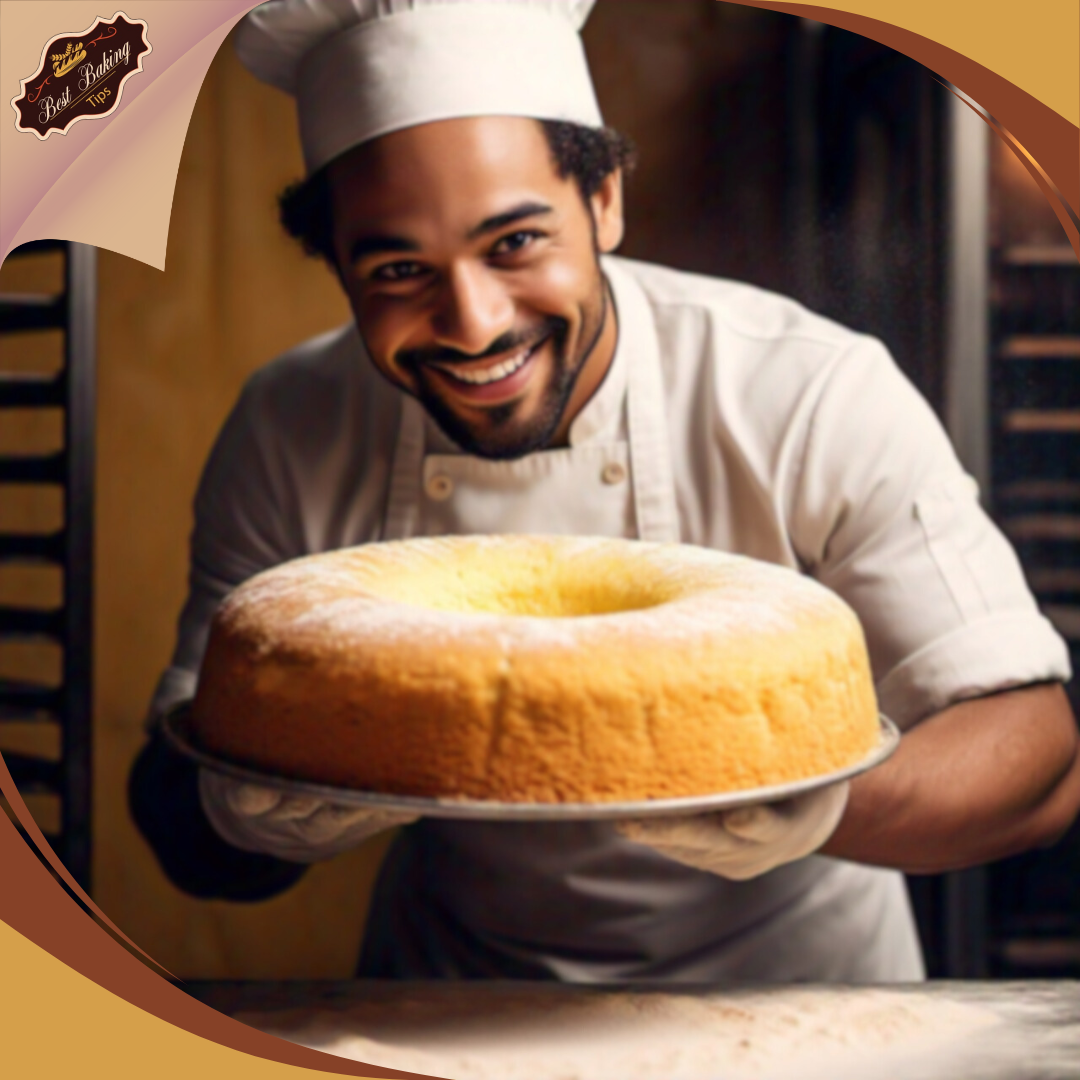
Offset Serrated Knife
Pros:
- Knuckle Clearance: Protects your knuckles from scraping the cutting board, especially when slicing large loaves.
- Control: The offset handle allows for more control over the serrated blade, which can help make precise cuts.
Cons:
- Price: Generally more expensive than straight serrated knives.
- Bulkier: The offset handle can take up more storage space.
Straight Serrated Knife
Pros:
- Price: Typically more affordable than offset serrated knives.
- Compact: The straight handle makes for a more compact serrated knife that’s easier to store.
Cons:
- Knuckle Clearance: There’s a higher chance of scraping your knuckles on the cutting board, especially with larger loaves.
- Control: It may offer slightly less control over the serrated blade than offset knives.
Based on Your Needs
If knuckle clearance and precise control are important to you or if you often cut large loaves, an offset serrated knife is a good choice.
If affordability and storage space are a concern, and you typically cut smaller or medium-sized loaves, then a straight serrated knife may be sufficient.
Ultimately, the best way to choose the best serrated knife is to try out both types and see which one feels more comfortable and maneuverable in your hand.
Differences Between Bread Knives and Kitchen Knives
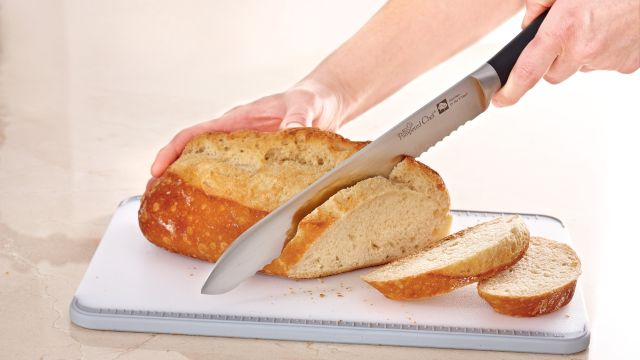
Photo by: Pampered Chef Blog
The biggest difference in using a bread knife compared to other kitchen knives is their blade design and how they interact with food. Here’s a breakdown:
Bread Knife
- Blade: Has a long, serrated edge with pointed teeth. These teeth act like small saws, gripping and tearing through the food as you use a sawing motion.
- Purpose: Designed to cut through bread without crushing the soft interior or tearing the crust. You can also use it for other foods with a soft inside and a hard outside, like tomatoes, cakes, or melons.
- Benefits: Clean cuts through crusty bread, minimal crushing of soft foods, sawing motion reduces effort.
- Drawbacks: Serrated edges can be harder to sharpen at home, which is not ideal for precise cuts.
Kitchen Knives (Chef’s Knife, Paring Knife, Utility Knife)
- Blade: These sharp knives typically have a smooth, straight edge for precise cutting. Chef’s knives may have a slightly curved belly for rocking cuts.
- Purpose: Designed for various tasks like chopping, slicing, dicing, and mincing different ingredients. Each knife type (chef’s, paring, utility) has a specific size and blade shape suited for different cutting needs.
- Benefits: Precise cuts for various ingredients, smooth cuts through vegetables and meat, versatile for different tasks.
- Drawbacks: It can crush soft bread or tear delicate foods, and it requires a more downward chopping motion that can be tiring for large quantities.
In short, bread knives are perfect for slicing through foods with a hard crust and soft interior, like bread. On the other hand, kitchen knives are versatile and great for various cutting tasks, but they use a different technique and might be less effective on softer foods.
Can I Use Other Serrated Knives for Slicing Bread?
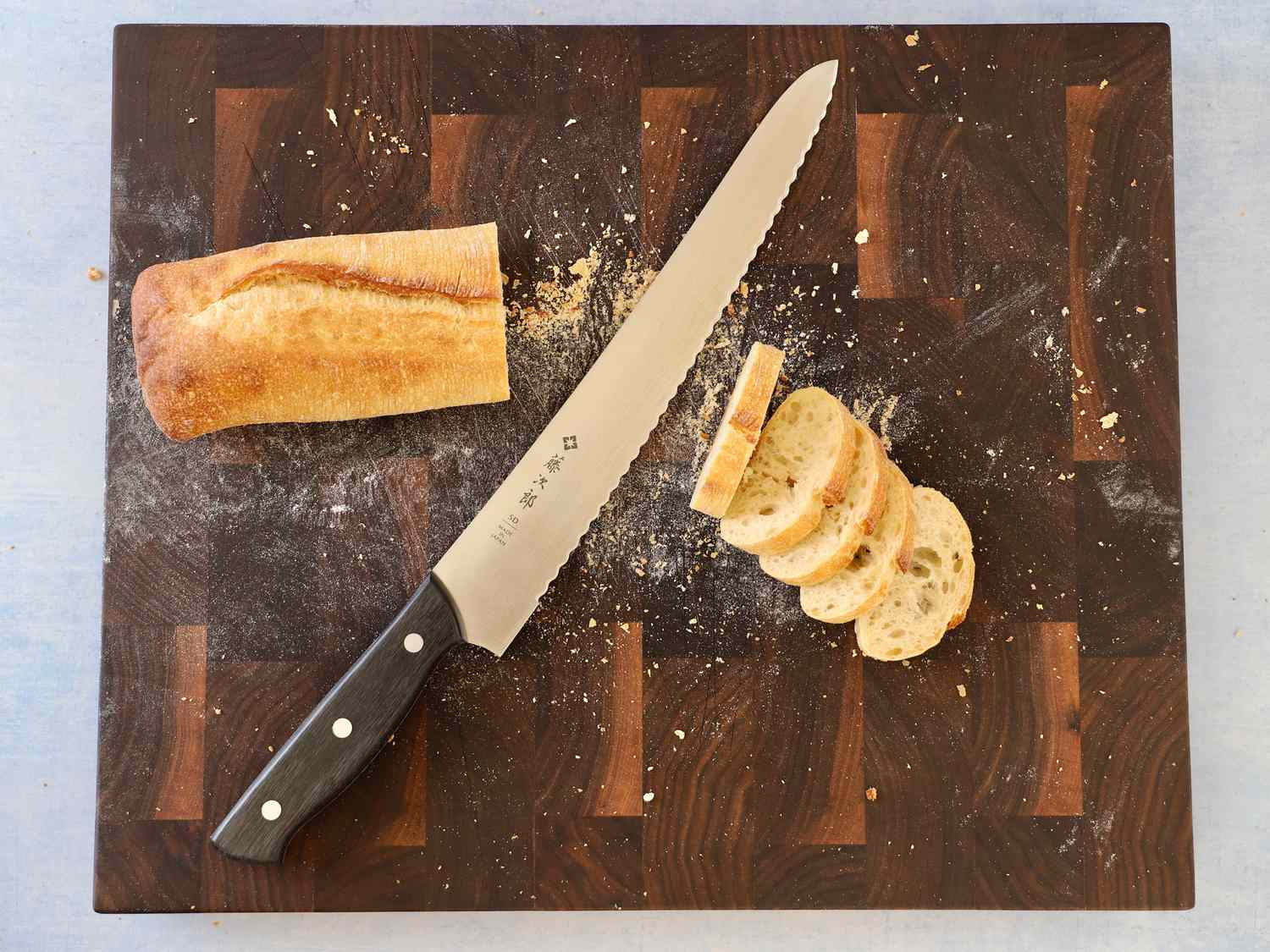
Photo by: Serious Eats
You can try using other serrated knives for slicing bread, but a dedicated knife for bread will likely give you the best results. Here’s why:
Bread Knife vs. Other Serrated Knives
- Serration Design: Bread knives, especially the best serrated bread knives, have specifically designed serrations with a fine or wavy edge. These serrations are ideal for gripping the bread crust and sawing through it without tearing the soft interior. Other serrated knives, like steak or utility knives, might have larger or more aggressive serrations that could tear the bread more.
- Blade Length: Bread knives typically have a longer blade (8-10 inches) that allows you to make clean, even slices through larger loaves. Other bread or serrated knives might be shorter, making them less ideal for bigger breads.
- Blade Flexibility: Bread knives often have a slight blade flexibility that helps them conform to the curves of the bread while cutting. This reduces tearing and makes maneuvering around the loaf easier. Other serrated knives might have stiffer blades.
While a Bread Knife is Ideal, Here’s When Other Serrated Knives Might Be Okay:
- Small Loaves or Rolls: If you’re cutting small loaves or rolls, another knife for bread or a serrated steak knife could work in a pinch.
- In a Pinch: If you don’t have a bread knife and need to cut bread, another serrated knife is better than a regular knife, which would likely crush the bread.
Here’s a video about the best knife for bread.
By: Kitchen Products
Caring for Your Bread Knife: Tips for Longevity and Sharpness
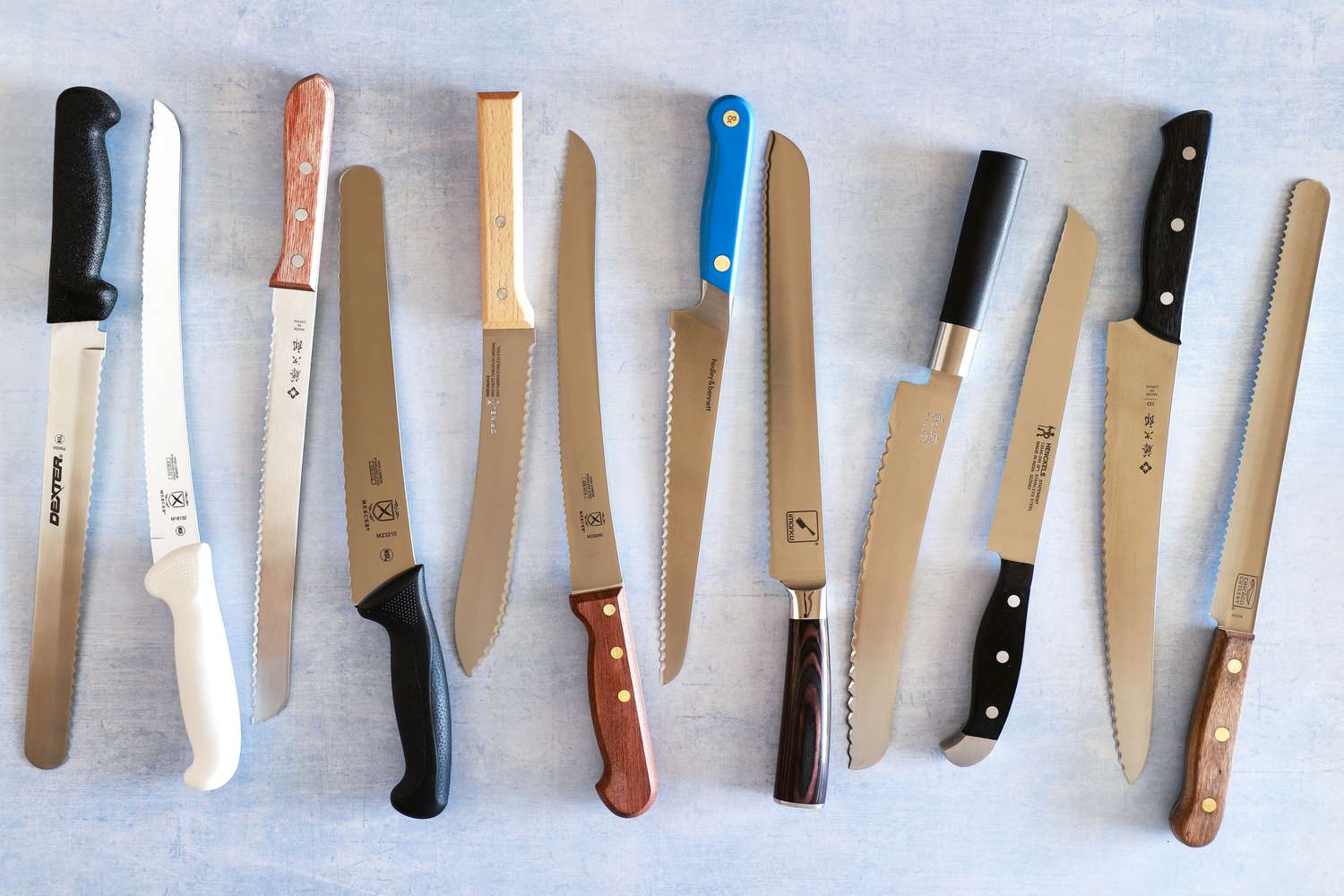
Photo by: Serious Eats
Here’s how to care for your bread knife and keep it slicing perfectly for years to come:
Washing
- Handwash Only: Avoid the dishwasher. The harsh detergents and banging around with other utensils can damage the serrated edge and warp the blade.
- Warm Soapy Water: Wash the knife with warm water and dish soap after each use.
- Gently Clean the Serrations: Use a soft sponge or dishcloth to clean food particles between the serrations.
Drying
- Don’t Air Dry: Water droplets can leave mineral deposits on the blade, leading to rust.
- Towel Dry Thoroughly: Immediately after washing, dry the knife completely with a clean tea towel. Make sure to dry in between the serrations as well.
Storing
- Safe Place: Store your knife in a safe location where it won’t get bumped or scratched by other utensils.
- Knife Block: This classic option keeps knives organized and protects the blades.
- Magnetic Knife Strip: This space-saving option allows easy access to the knife and promotes air circulation to prevent rust.
- Sheath: Some bread knives have sheaths that protect the blade during storage.
- Sharp Edge Facing Away: Store the knife with the sharp edge facing away from you to prevent accidental cuts while reaching for it.
Sharpening
- Honing vs. Sharpening: Bread knives don’t necessarily need frequent sharpening but benefit from regular honing. Honing with honing steel realigns the bent teeth of the serrations, maintaining their effectiveness. On the other hand, sharpening removes metal from the blade and is typically not recommended for serrated knives as it can alter the serration pattern.
- Honing with Honing Steel: Use a honing steel designed for serrated knives. Hold the steel vertically on a stable surface and gently draw the knife down the rod at a 20-degree angle several times on each side of the serrations.
Additional Tips
- Use a Cutting Board: Use a cutting board for your bread knife. This protects the blade and your countertop.
- Cut Straight: Avoid sawing back and forth with the knife. Use a sawing motion with a slight forward push to cut through the bread in a clean, straight line.
- Don’t Force the Cut: Use a sawing motion with gentle pressure if the bread is tough. Don’t force the knife through the bread, as this can damage the serrations.
Following these simple care tips, you can ensure your bread knife stays sharp, effective, and ready to tackle any loaf for years.
Here’s a video about how to sharpen your knife for bread.
By: knivesandtools
Mastering Bread Slicing with the Best Bread Knife
Investing in the best knife for bread transformed my experience in the kitchen, making it easier to achieve perfect slices of bread every time. Whether slicing through crusty loaves or delicate pastries, these quality serrated bread knives were designed to grip the crust without crushing the soft interior, ensuring clean, even slices.
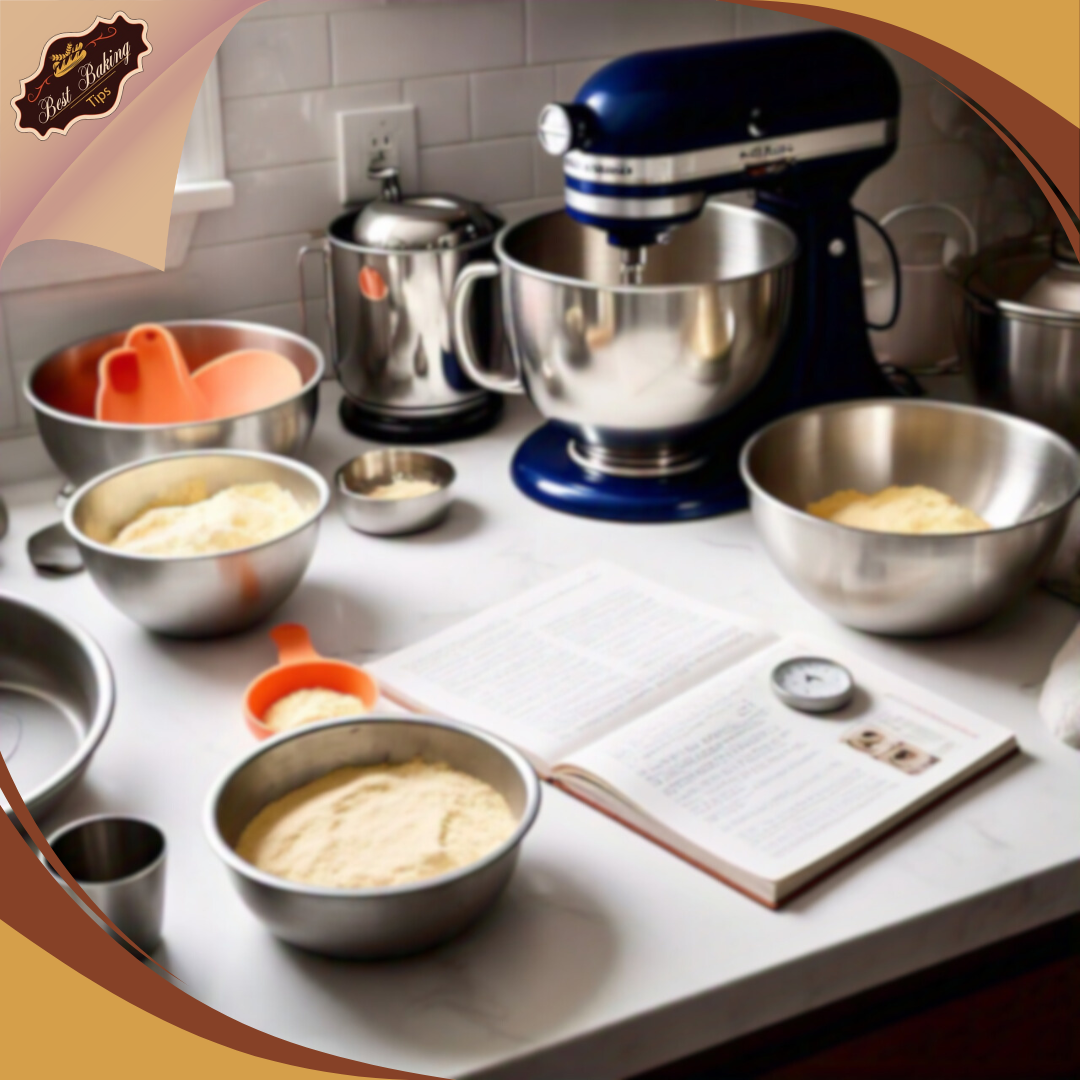
The bread knife’s longer blade provides superior control, leverage, and maneuverability, allowing you to effortlessly navigate the curves of different bread sizes. This versatility makes it an essential tool for any baker or home cook passionate about achieving professional-looking results. Proper care, including handwashing and storing in a safe place, maintains your knife’s sharpness and effectiveness over time.
By following these tips and understanding the benefits of a dedicated knife for bread, you can make every slice perfect, enhancing your enjoyment of freshly baked bread and other culinary creations.
FAQS
What Are the Differences Between Scalloped and Serrated Knives?
Both scalloped and serrated knives are great for cutting bread, but they do it a bit differently:
A serrated knife resembles a tiny saw with sharp points that tear through bread. It’s perfect for crusty bread but can leave crumbs and might squash softer types.
On the other hand, scalloped knives have wavy blades with rounded bumps. They grip the bread and slice through it, leaving cleaner cuts with less tearing. They work well for all types of bread; some can even be cut through tomatoes and other soft fruits and vegetables.
How to Choose the Best Bread Knife?
When selecting a bread knife, consider the length of the blade (usually 8-10 inches), the quality of the serrations, the handle design for comfort and control, and whether you prefer an offset or straight design.
Can I use a Bread Slicer instead of a Bread Knife?
It depends on the type of bread slicer you have:
- Electric Bread Slicer: An electric bread slicer is not a good substitute for a knife. While it can give you uniform slices, it tends to crush soft bread and isn’t ideal for crusty loaves. Additionally, it is bulkier and requires cleaning a whole appliance.
- Manual Bread Slicer (wire slicer): A manual bread slicer, specifically a wire slicer, can be okay for soft bread if you need perfectly even slices. However, it won’t work well on crusty bread and can tear it. It might also be tricky to maneuver for thicker loaves.
Elevate Your Baking Skills with Us!
? Follow us on Facebook, Instagram, Pinterest, Twitter, and TikTok for:
- Engaging content
- Expert advice
- Product reviews
- Tips and techniques
Join our passionate baking community and discover the best tools and tips to create delicious treats at home!
#BakingBrilliance #BakingTips #BakingCommunity #BakeWithUs

